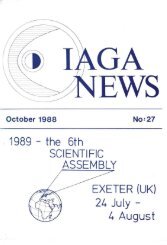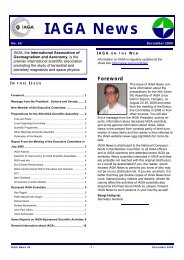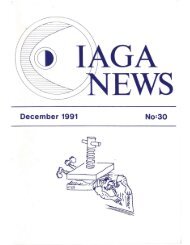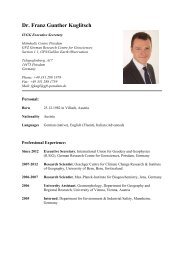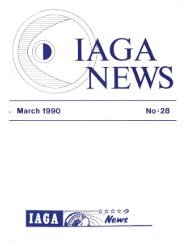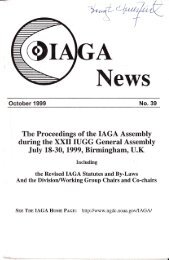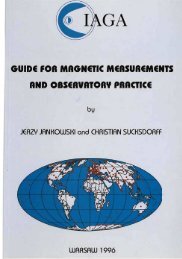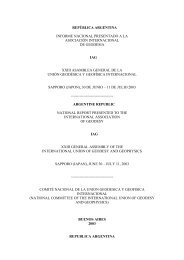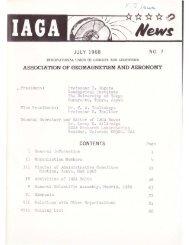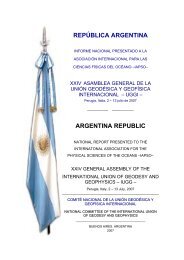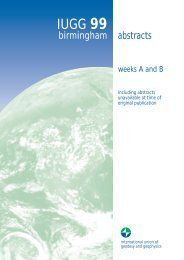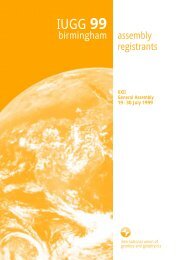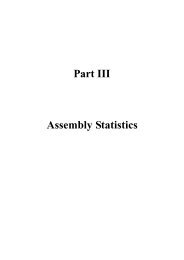IAGA News 2011 - IUGG
IAGA News 2011 - IUGG
IAGA News 2011 - IUGG
Create successful ePaper yourself
Turn your PDF publications into a flip-book with our unique Google optimized e-Paper software.
which can lead to new findings and progress on risk mitigationinVolcanologyandonEarthquakes.<br />
Twoprograms<br />
are now ongoing in the Philippines and in Kyrgyzstan.<br />
J. Zlotnicki, M.J.S. Johnston, T. Nagao<br />
3.7 eGYAfrica Workshop, Accra 2010<br />
eGYAfrica evolved from the Electronic Geophysical Year<br />
(www.egy.org) in response to the need for better Internet<br />
connectivity for research and education in Africa<br />
i.e., to help reduce the digital divide. The objective is<br />
to strengthen research and education in Africa to serve<br />
national interests and to increase African participation in<br />
international science.<br />
The two-day eGYAfrica Workshop and planning meeting,<br />
held in Accra in November 2010, was supported through<br />
a grant from <strong>IUGG</strong>, together with additional support from<br />
<strong>IAGA</strong>. Seven African countries were represented. The first<br />
day focussed on Internet issues in Africa, particularly the<br />
digital divide, the rapid expansion of fibre-optic cabling<br />
around and within Africa, and the development of National<br />
Research and Education Networks (NRENs).<br />
The PingER Project that measures end-to-end Internet<br />
performance shows, despite this impressive progress, that<br />
a digital divide persists in Africa that hampers progress.<br />
Limitations at the institutional level are often an important<br />
factor.<br />
The second day was devoted to eGYAfrica review and<br />
planning. A solid working relationship was established<br />
with the Association of African Universities (Boubakar<br />
Barry, Head of the NREN Unit), and with ICSU’s Regional<br />
Office for Africa in Pretoria (Daniel Nyanganyura).<br />
Workshop participants were pleased with the progress of<br />
eGYAfrica and were enthusiastic about its future; officers<br />
were elected for the eGYAfrica Committee for the next 2<br />
years, andamonographbasedonthethemesofeGYAfrica<br />
and the developments of NRENs in Africa is planned. A<br />
key activity of eGYAfrica is to establish national groups<br />
who will seek to influence decision-makers. This is is currently<br />
being pursued in Cote d’Ivoire, Ethiopia, Ghana,<br />
Kenya, Nigeria, Rwanda, Senegal, and South Africa. The<br />
importance of working through existing groups when possible<br />
was emphasized.<br />
A full report about the Workshop is at:<br />
http://dl.dropbox.com/u/31851729/eGYAfrica%<br />
20Workshop2010.doc<br />
V. Chukwuma, A. Mebrahtu, C. Barton<br />
4 Deceased <strong>IAGA</strong> Scientists<br />
Ian Gough (1922 - <strong>2011</strong>)<br />
Ian Gough was born on 20<br />
June 1922 in Port Elizabeth,<br />
South Africa. He received<br />
a B.Sc and M.Sc. from<br />
Rhodes University (in 1943<br />
and 1947, respectively), and<br />
a Ph.D. from the University<br />
of Witwatersrand in<br />
1953. From 1947 to 1958<br />
he worked as a researcher<br />
at the South African Council<br />
for Scientific and Industrial Research, before moving<br />
to academe where he spent the rest of his career. In<br />
the years 1958-1963 he was at the University College of<br />
Rhodesia and Nyasaland (in what is now Harare, Zimbabwe),<br />
followed by a short period (1964-1966) at the<br />
Southwest Center for Advanced Studies in Dallas, Texas.<br />
Thereafter, he moved to the University of Alberta in Edmonton,<br />
Canada where he remained on the faculty until<br />
his retirement in 1988.<br />
Ian had a rich and productive research career in his chosen<br />
field of geophysics. He published more than 100 papers in<br />
first-class international scientific journals, and made seminal<br />
contributions to a very wide range of topics in the<br />
earth sciences. He belonged to a generation of scientists<br />
who approached scientific work very much from first principles.<br />
Given a need to bring observations to bear on a<br />
particular problem, he set about designing, constructing,<br />
and operating the necessary apparatus. I well remember<br />
him preparing the unique Gough-Reitzel magnetometers<br />
foranupcomingfieldseason–rowsofverticalmetaltubes<br />
standingtoattentionlikeasquadronofsoldiersonparade.<br />
And each one containing a sensitive magnet system and<br />
an ingenious home-made camera. He was simultaneously<br />
commanding officer, quartermaster, and chief mechanic.<br />
One thinks of Newton polishing mirrors for his own telescope,<br />
or of Faraday co-opting a giant link from an anchor<br />
chain to construct his electromagnet. Deployed as arrays<br />
across wide stretches of North America, South Africa, and<br />
Australia,Ian’smagnetometersrevealedhithertounknown<br />
structures in the Earth’s crust, such as an ancient platetectonic<br />
boundary stretching more than 1000 km through<br />
the Canadian Shield and down into Wyoming.<br />
Another example of this hands-on way of doing science<br />
was the Gough spinner magnetometer, built in the days<br />
when nothing was available off-the-shelf, but at a time<br />
when the ability to measure the weak ‘fossil’ magnetism<br />
in rock samples was crucial to establishing the reality of<br />
the way in which the Earth’s magnetic poles, and the<br />
continents themselves, have drifted about over huge distances;<br />
the sort of data which would ultimately underpin<br />
the modern theory of plate tectonics. These examples are<br />
but two from a long list that includes the accurate determination<br />
of the amount of thermal energy flowing out<br />
of the Earth, the seismic activity induced by the filling of<br />
large reservoirs, and the speculation that the supercontinent<br />
Gondwanaland was cracked apart by the weight of<br />
<strong>IAGA</strong> <strong>News</strong> <strong>2011</strong> – Page 10



